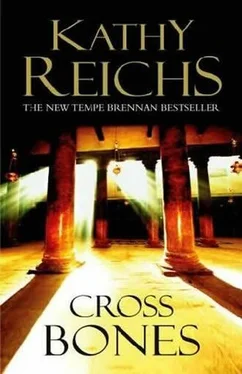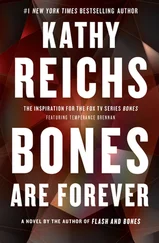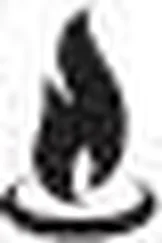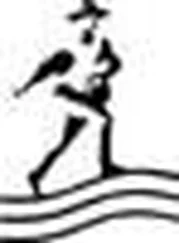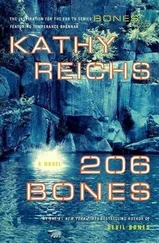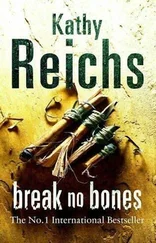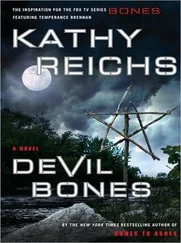“Could it be that Blotnik seemed unconcerned becausehe has the skeleton?”
“Long shot. The guy’s a wimp.” Jake cut me a look. “But if he does, I’ll kick his ass from here to Tel Aviv.”
We also discussed Getz’s comments.
“Not exactly garrulous, is she?”
“Esther’s direct.”
Not the descriptor I’d pinned on the Getzster.
“But you liked what she saw,” I said.
“Damn right. Clean hair. No vermin. Imported fabric. And wool was a luxury back then. Most shrouds were exclusively linen. Whoever this boy was, he had social standing.” Jake shot me another look. “And a hole in his heel bone. And relatives with names straight out of the Gospels.”
“Jake, I’ve got to admit, I’m skeptical. First the Masada skeleton, now these shroud bones. Are you talking yourself into something because you desperately want it to be true?”
“I’ve never believed the Masada skeleton is that of Jesus. That was Lerner’s interpretation, based on the cocked-up thinking of Donovan Joyce. But I do think the bones are those of someone who shouldn’t have been up on that rock. Someone whose presence is going to make the Israelis, and maybe the Vatican, pee their shorts.”
“A nonzealot.”
Jake nodded.
“Who?”
“That’s what we’re going to find out.”
We rode in silence for a while. Then I went back to the shroud.
“Is the shroud I found in the tomb similar to the shroud of Turin?” I asked.
“The Turin cloth is linen, and has a more complicated, three-on-one twill weave. Which makes sense. That shroud dates to the medieval, somewhere between 1260 and 1390C. E. ”
“Carbon-fourteen dated?”
Jake nodded. “Confirmed by labs in Tucson, Oxford, and Zurich. And the Turin shroud was a single garment for the whole body. Ours is a two-part deal.”
“What’s current thinking on the Turin image?” I asked.
“Probably resulted from oxidation and dehydration of the cellulose fibers of the cloth itself.”
Another wham-o for the Vatican.
Getting to the university took less time than finding a spot to park. Jake finally wedged his rented Honda into footage meant for a scooter, and we set off toward the eastern end of campus.
The sun beamed down from an immaculate blue sky. The air smelled of freshly cut grass.
We walked through patches of shadow and light, past classrooms, offices, dorms, and labs. Students drank coffee at outdoor tables, or strolled wearing bandannas, backpacks, and Birkenstocks. A kid tossed a Frisbee to his dog.
We could have been on any campus in any city in the world. High atop its Mount Scopus hilltop, Hebrew University was an island of tranquillity in an urban sea of sentries, barricades, smog, and cement.
But nothing in this land is immune. As we walked my mind superimposed images on the peaceful tableau. Newsreel footage: July 31, 2001. A day much like this one. Students taking exams or registering for summer courses. A parcel left on a café table. Seven killed, eighty injured. Hamas claimed responsibility, retaliation for Israel’s assassination of Salah Shehadeh in Gaza City. Fourteen Palestinians dead there.
And the beat goes on.
The gatekeeper at the Institute of Archaeology was a woman named Irena Porat. A decade older, with a fashion sense that ran toward the fuzzy and the floral, Porat was considerably less menacing than Esther Getz.
Shaloms were exchanged.
Porat spoke to Jake in Hebrew.
Jake answered and, I assumed, reminded Porat of his call.
As Jake explained our purpose, Porat inspected something crumbly she’d found in her ear. I caught the word “Masada,” and Yadin’s name.
When Jake finished, Porat asked a question.
Jake answered.
Porat said something, then tipped her head toward me.
Jake responded.
Leaning close, Porat spoke to Jake in a lowered voice.
Jake nodded, face solemn.
Porat gave me her best welcoming smile.
I returned her smile, a trusty co-conspirator.
Porat led us down two flights of stairs to a grim, windowless room. The walls and floor were gray, the furnishings battered tables, folding chairs, and rows of floor-to-ceiling shelves. Large boxes filled two corners.
“Please.” Porat pointed the ear-probe finger at me, then at a table.
I sat.
Porat and Jake disappeared into the shelving. When they emerged Jake carried three large brown corrugated files. Porat lugged another.
Dumping her file on the table, Porat gave one final instruction, one final smile, and withdrew.
“Nice lady,” I said.
“A bit heavy on the angora,” Jake said.
Each file was identified in Hebrew in black Magic Marker. Jake lined them up, selected the first, and removed the notebooks it contained.
Jake selected one, I took another.
European-size plain paper. Hebrew typing on one side.
I flipped a few pages.
I could read nothing.
Crash course. Jake wrote a list of phrases that would serve as flags: Yoram Tsafrir. Nicu Haas. Cave 2001. Skeleton. Bone. He also showed me how to read Hebrew dates.
Jake started with the earliest notebook. I took the next in sequence. Using my list, I scouted ahead, Sesame Street -style. What looks the same? What looks different?
I came up with a lot of false hits. We’d been at it an hour when I got my first real one.
“What’s this?” I asked, sliding the notebook to Jake.
Jake skimmed the text, sat forward.
“It’s the October twentieth, 1963, meeting. They’re talking about Cave 2001.”
“What’re they saying?”
“Yoram Tsafrir is reporting on his progress in another cave, 2004. Listen to this.”
I definitely was.
“Tsafrir says the finds are ‘…much more beautiful than the pieces found in Cave 2001 and 2002.’”
“So Cave 2001 was explored earlier than October twentieth,” I said.
“Yes.”
“Didn’t the dig begin in early October?”
Jake nodded.
“So the cave must have been discovered in the first two weeks of excavation.”
“But I found no mention of it until this entry.” Jake frowned. “Keep going. I’ll go back through the pages I’ve done.”
The next reference to Cave 2001 was on November 26, 1963, over a month later. Haas had been invited to join the group.
“Haas is reporting on the three skeletons from Locus 8, that’s the northern palace area, and Locus 2001, that’s the cave bones.” Jake’s finger moved over the text. “He says there are twenty-four to twenty-six persons and a six-month fetus. Fourteen males, six females, four children, and some unknowns.”
“We know the figures don’t add up,” I said.
“Right.” Jake looked up. “But more to the point: Where is any previous discussion of the cave and its contents?”
“Maybe we missed it,” I said.
“Maybe.”
“Let’s reread everything prior to October twentieth,” I suggested.
We did.
There wasn’t a single mention of the cave’s exploration or excavation.
But I did learn something.
The pages were numbered. In Arabic.
I could read Arabic numbers.
I went back through the period in question.
Pages were missing from the early weeks of October.
With a growing sense of dread, we rechecked every notebook in every file.
The pages hadn’t been improperly cataloged.
They were gone.
“CAN MATERIALS BE CHECKED OUT?” IASKED.
“No. And Porat assured me we have everything in the collection.”
“If the pages were removed, it had to be internal.”
We considered in silence.
“Yadin announced the discovery of the palace skeletons at a press conference in November of sixty-three,” I said. “Clearly, he was interested in human remains.”
Читать дальше
